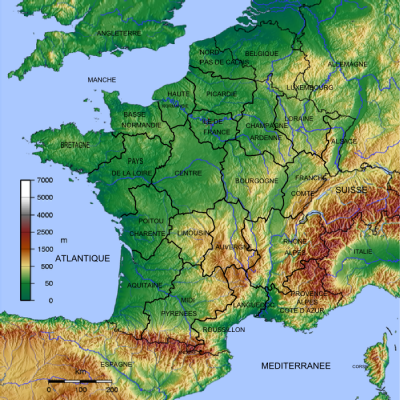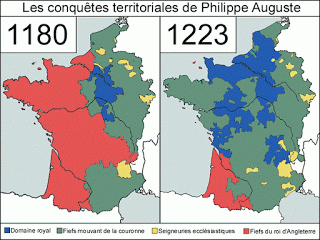
England’s first try for dominance in France fails. Continuing our series on France’s Wars. Did you ever notice that in almost every great war in history, France has been involved in some way? These stories emphasize the French role in these wars.
SUMMARY: By 1200 the Kings of England had inherited or conquered over half of France. When Richard the Lionheart died in 1199 and his brother John inherited the throne and his French possessions, King Philip II of France determined to make his sovereignty over those lands real. For two years (1202 – 1204) the two kings fought the climatic war of the Angevin Era.
DURATION: 1202-1204.
BACKGROUND: After William the Conqueror invaded England in 1066, he and his descendants kept their title of Duke of Normandy and control over that land. Hence, they were both independent equals of the Kings of France and their subjects, too. Afterwards, marriages brought the English Kings the additional lands and titles of Duke of Aquitaine, Count of Anjou, and other titles and areas of control. Henry II (reigned 1154 – 1189) expanded and consolidated his holdings in France, Scotland, and Ireland.
Philip II was coronated King of the Franks in 1180 and signaled his policy by designating himself “King of France”. It was like a Declaration of Independence. All future kings of France used this new title. France was officially born.
A series of wars with the English king commenced, first with Henry and then with Richard. There was an interruption for the Third Crusade (1190 – 1192) but while Richard was still in the Holy Land wresting castles from the Saracens, Philip rushed home to resume operations against English interests in France. On the way home, Richard was arrested and imprisoned in Germany. Philip used the time to reconquer most of Normandy. When Richard got out, he took control of the English army and restored his holdings in France.
Richard began building the ultimate castle of the age on the east bank of the Seine River below Paris in 1196. Construction of just this one castle cost more than twice as much as all castle construction in England combined. Richard supervised the building and shrunk construction time from a decade to just two years. It’s name was “Chateau Gaillard “ and it contained innovations that castles would still be adopting a century later. Richard boasted that he could hold this castle “were the walls made of butter”.
But he died in 1199 and his brother John inherited the throne, the noble fiefdoms, and the King of France’s determination of doom.
MAJOR COUNTRIES
- France
Weakened by feudalism and aristocratic quarrels but with a new king with a new title and a new sense of national purpose. - Opponent: England
A part of a union of many lands, a proto-major power, but could these lands be homogenized into a functioning empire?
MAJOR LEADERS
- France
King Philip II (1116 – 1131) comes across as a craven schemer, especially compared to the hero warrior Richard the Lionheart. He had one goal, uniting France. He considered the Crusades a distraction and acted accordingly. - England
- King Henry II (1154 – 1189)
He formed the Angevin Union of French fiefdoms through inheritance, marriage, diplomacy, and war. - King Richard I (1189 – 1199),
During just the 10 years he ruled, he fought the biggest of the Crusades, restored England’s holdings in France, built the best castle of early Medieval times, and still spent years in prison (1192 – 1194). - King John (1199 – 1216),
The only English king of that name, he could occasionally fight well but he governed badly. This is the king of the Robin Hood legend (together with Richard) and of the real-world Magna Charta.
- King Henry II (1154 – 1189)
- Other
Eleanor of Aquitaine, Queen of France (1137 – 1152) and then of England (1154 – 1189), after that Queen Dowager. It was her decision to dump the King of the Franks and marry the King of England which formed the Angevin Union.

This map shows a before and after of the reign of Phillip II of France. The borders continued to change throughout this time. Legend: Orange=England, Blue=French kings, Green=French nobles, Yellow=Church.
NARRATIVE: Significant operations were more political and diplomatic in nature than military. The history chronicles many battles and sieges but there were two operations that really mattered.
One was John’s misrule. The biggest example of that is this. The government of Normandy, the foundation of his proto-empire, was given to a bunch of mercenaries who saw their opportunity to plunder and rape the duchy. Appeals to King John did nothing. Nobles and commoners alike turned their sympathies to the King of France.
The second operation began with King John’s botched murder of his nephew Duke Arthur of Brittany. With rebellion against John in Brittany and discord everywhere else, John reversed his announcement of Arthur’s death and produced him alive and whole. He kept Arthur as his prisoner for a time but then he disappeared. Suspicion of murder fell on John. Even if he did not do that, his behavior before, during, and after the disappearance caused that suspicion to fall on him.
Rebellion behind the lines, public discontent all around, and Philip’s army in front hampered John’s military operations.
In late August, 1203 Philip decided it was time to punch out with a knockout blow. He attacked Chateau Gaillard. The castle was on the right bank of the Seine River; Philip based his army on the left bank and built a causeway across the river. The English had fortified a small island in the middle of the river and that is where Philip’s first objective. King Richard, as part of his defensive preparations of the castle, had assembled and stored a small fleet of boats that could be rowed upriver to break a siege. John now used those boats to attack upriver by land and by sea. He hit the French with a surprise attack just before dawn on August 31st. The land force hit first but was beaten back amid some disarray among the French army. The boats were delayed. When they hit, it was daylight and the French had had enough time to regroup. The result of this battle was that the English abandoned the island and retreated into the castle proper.
John was bereft of support in Normandy. Sadly, he returned to England to raise funds and another army. Both came too late. On March 6, 2004 Chateau Gaillard fell. The way into Normandy was cleared.
Philip negotiated, demanded, and got surrenders from the towns and castles of the land. The main city of Rouen opened its gates to him on June 24th. For this war, this event was equivalent to Lee surrendering to Grant in the American Civil War. While there were other forces technically in the field, everyone recognized that the war was over and who had won it.
AFTERMATH: Out of the debacle England kept Gascony, a dream of empire and glory, and a grudge that a century later would cause the 100 Years War.
| <—Previous | Master List | Next—> |
Further Information: here and here and below.
 |
Leave a Reply
You must be logged in to post a comment.